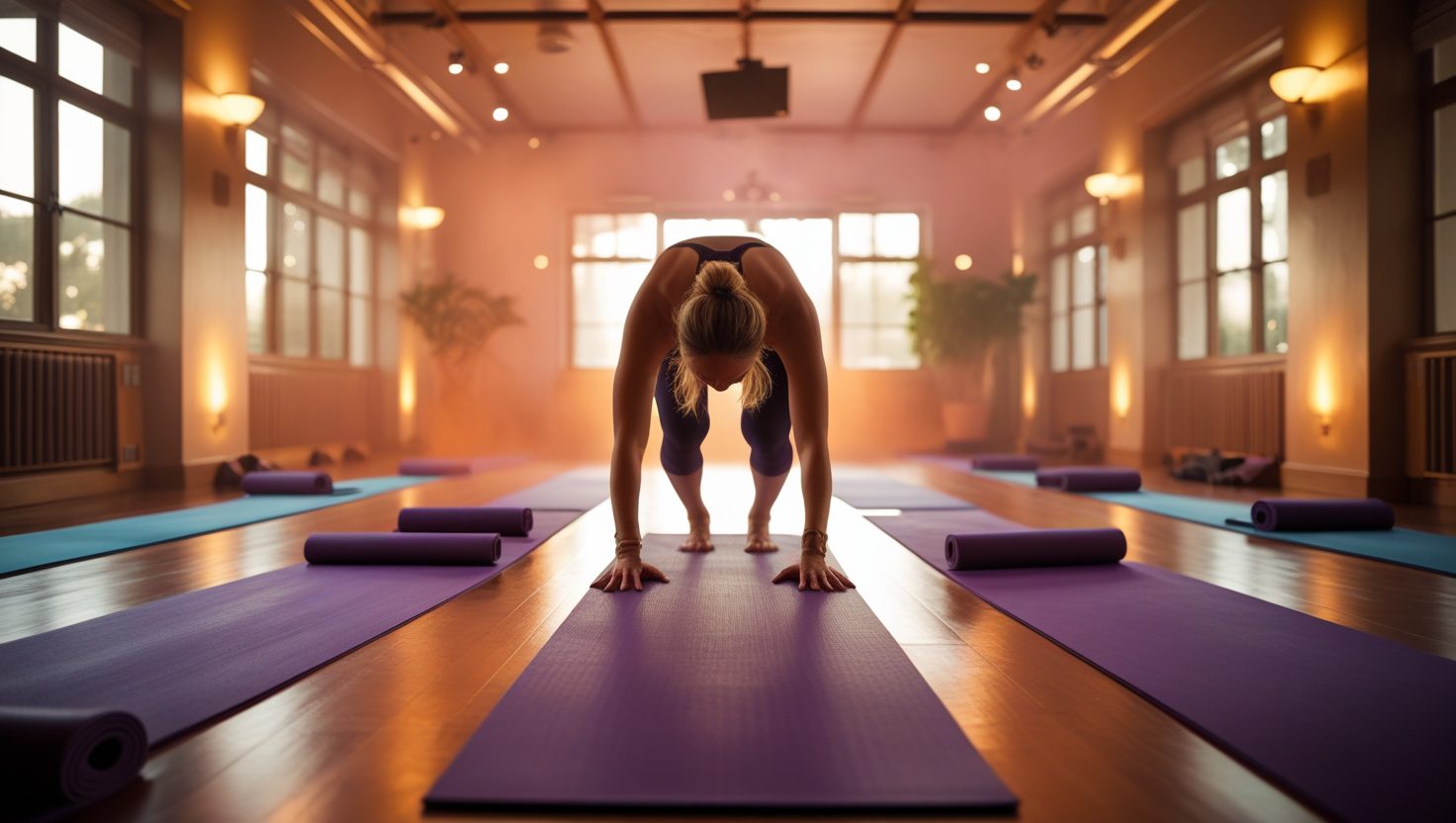If you’re thinking about trying Bikram yoga—or already powering through those steamy classes—the mat you choose can make or break your experience. I found that out the hard way. I started with a basic yoga mat from home and spent the entire class slipping and sliding, totally distracted. It wasn’t until I switched to a mat made for Bikram yoga that everything changed. My grip improved, my focus returned, and I could finally move with confidence.
This guide is here to save you from that same frustration. You’ll learn what sets a Bikram Yoga Mat apart, how to choose the right one for your needs, how to care for it properly, and which mistakes to avoid. By the end, you’ll know exactly what to look for—and walk into that heated room feeling steady, supported, and ready to flow.
What’s So Special About a Bikram Yoga Mat?
It’s all about the heat and the sweat. Bikram yoga isn’t like other types of yoga. It happens in a hot room, usually around 105°F. You move, you stretch, and you sweat. A lot. That’s why a regular yoga mat just doesn’t cut it. A Bikram Yoga Mat is built for this exact kind of practice. It’s made to handle heat, grip through sweat, and stay strong over time. Let’s break down what makes it so different.
Thickness That Supports You Without Throwing You Off
In Bikram yoga, you do plenty of poses on the floor. Think deep stretches, twists, and backbends. You need a mat with enough padding to protect your joints. But it can’t be too thick or you’ll lose balance. The sweet spot is around 5 to 6 millimeters. That’s just enough cushioning without feeling wobbly.
Grip That Holds Even When You’re Dripping
You’re going to sweat. No way around it. And once your hands or feet get wet, slipping becomes a real problem. That’s why Bikram mats come with a textured surface. It helps you stay steady even when your mat gets damp. Good grip means fewer distractions and safer movement between poses.
Sweat Absorption That Keeps Things Manageable
This is huge. In regular yoga, a little sweat isn’t a big deal. In Bikram, it’s everywhere. A good Bikram mat absorbs moisture or has a top layer designed to work well with a towel. That way, you’re not sliding around. You stay focused, stable, and more in control.
Durability That Lasts Through the Heat
Bikram yoga is intense. Many people practice several times a week. That adds up fast. You need a mat that won’t fall apart after a few classes. A good one holds up to heat, moisture, and frequent use. The best Bikram mats are made from high-quality materials that resist wear and tear.
Why It All Matters
A Bikram Yoga Mat isn’t just a surface. It’s your foundation. With the right mat, you move better. You sweat more comfortably. You worry less. And that lets you focus on what really matters—your breath, your poses, and your progress.
Now you know what to look for in a Bikram Yoga Mat, why not take it a step further and explore some top-rated options? In my detailed review of the 10 Best Bikram Yoga Mats, I’ve tested and compared various mats so you don’t have to. Check out the full review to find the perfect mat that fits your needs!
Choosing the Right Bikram Yoga Mat
Picking the right mat can make a big difference in how you feel during class. When I started Bikram yoga, I had no idea how to choose the right mat. I just thought any mat would work. But once I stepped into that hot room and started slipping and sliding, I knew I needed something better.
Here’s what to look for when choosing your Bikram Yoga Mat.
1. Material Matters
The material of your mat changes everything. It affects how it feels, how long it lasts, and how well it handles sweat.
Here are the most common types:
PVC is popular. It gives great grip, lasts a long time, and handles moisture well. But it’s not eco-friendly.
TPE is more earth-friendly. It’s lighter and still grips nicely. It might not last as long as PVC, but it’s a solid middle ground.
Natural rubber is perfect if you care about sustainability. It grips well, soaks up sweat, and comes from renewable resources. Just know it’s heavier than other options.
Ask yourself what matters most to you. Do you care about the planet? Do you want something that lasts for years? Or are you focused on grip above all else?
2. Pick the Right Size
Most mats are 24 inches wide and 72 inches long. That works for many people. But if you’re tall or like extra space, go for something longer. Mats that are 80 inches long give you more room to stretch. You want to move freely. Your mat should feel like a safe zone, not a tight squeeze.
3. Pay Attention to Texture
Texture helps keep you from slipping. A smooth mat might look nice, but it gets slick fast in a hot class. A textured mat grips better, even when it’s soaked in sweat. Look for little ridges or bumps on the surface. They add traction and help you stay grounded. Texture also adds comfort. When you’re lying down or doing seated poses, it feels good to have just a bit of softness.
4. Consider the Weight
How heavy your mat is might seem like a small thing. But if you’re carrying it to and from class every day, you’ll notice it fast. Lighter mats are easier to move around. They’re great if you’re going to a studio. Look for something in the 3 to 5 pound range. Heavier mats offer more cushion and don’t shift around. They’re great for home use. These usually weigh between 5 and 6 pounds. Think about your lifestyle. Are you always on the go, or do you mostly practice at home? Your answer will help you pick the right weight.
Ready to take your Bikram yoga practice to the next level? I’ve reviewed the 10 Best Bikram Yoga Mats, each handpicked for its durability, grip, and sweat absorption. Head over to the full review and find the mat that will elevate your practice today!
How a Bikram Yoga Mat Enhances Your Practice
A good Bikram Yoga Mat makes a big difference. In a hot, sweaty class, grip matters. The right mat keeps your hands and feet from slipping so you can focus on your poses, not on staying in place. I used to slide around constantly until I switched to a mat with better traction. It instantly improved my focus and flow. A proper mat also has just enough cushioning to support your joints without throwing off your balance.
Balance can be tricky in Bikram yoga. Poses like Tree or Warrior III demand a steady base. A quality mat gives you that stability. I remember how wobbly I felt in the beginning. Once I got a more supportive mat, I could hold poses longer and feel more grounded. That stable surface builds both strength and confidence.
Floor poses need comfort. Without enough padding, your knees and elbows take a hit. A cushioned mat protects your joints so you can relax into poses like Savasana or Camel. I still remember the first time I used a thicker mat—it felt so much better. No more shifting around to get comfortable. Just focus, breathe, and enjoy the practice.
How to Care for Your Bikram Yoga Mat
Taking care of your Bikram Yoga Mat is just as important as choosing the right one. All that heat and sweat can wear it down fast. But with a little effort, you can keep your mat fresh and long-lasting.
Clean your mat after every class. Bikram yoga is sweaty, and sweat left sitting can lead to smells and bacteria. I always wipe mine down with a damp cloth and a little water mixed with tea tree oil. It keeps it clean and smelling good. For a deeper clean, hand wash it with mild soap and water. Skip the harsh chemicals, especially if your mat is made from natural rubber. Rinse well and hang it to dry in a cool spot.
Storing your mat the right way also matters. Don’t leave it in direct sunlight. That heat can break down the material. I roll mine loosely and store it in a dry place. If it stays rolled up too tight for too long, it can get creases. Let it air out once in a while so it keeps its shape and stays ready for your next practice.
Common Mistakes Beginners Make with Their Bikram Yoga Mats
Even after selecting the right mat, beginners can sometimes make a few common mistakes when using their Bikram Yoga Mats. Let’s go over some of these mistakes and how to avoid them.
1. Using a Mat That’s Too Thin or Too Thick
As mentioned earlier, a mat that’s too thin won’t provide enough cushioning, while a mat that’s too thick can throw off your balance. If you find yourself on a mat that doesn’t feel right for your practice, don’t be afraid to try a different one. You want a mat that offers the right amount of support without making you feel wobbly or unstable.
2. Forgetting to Clean Your Mat After Sweating So Much
Sweat is a natural part of Bikram yoga, but it can lead to bacteria growth if left uncleaned. After each session, take a few minutes to wipe down your mat, especially if you’ve been sweating a lot. It’s an easy habit to get into, and your mat will thank you for it!
3. Not Considering Long-Term Maintenance
Your Bikram Yoga Mat is an investment in your practice, so be sure to take care of it. Regular cleaning, proper storage, and being mindful of wear and tear will help your mat last longer and stay in great shape. Don’t wait until it’s too late to give your mat the care it deserves.
Frequently Asked Questions (FAQ)
1. What makes a Bikram Yoga Mat different from a regular yoga mat?
Bikram Yoga Mats are built for heat, sweat, and endurance. Regular mats just can’t keep up in a 105°F room. The biggest difference is how well they handle sweat. Bikram mats absorb moisture so you’re not sliding around. They also offer better grip and more joint support during floor work. In a hot, intense class, that makes a huge difference.
2. How do I know if my Bikram Yoga Mat is high quality?
A great mat stays put, even when you’re dripping sweat. Check for strong grip, balanced thickness, and long-lasting material. A high-quality mat won’t wear out fast, lose traction, or smell weird. Natural rubber mats usually hold up well and don’t have that harsh chemical scent. If your mat feels solid and smells neutral, you’re on the right track.
3. How often should I replace my Bikram Yoga Mat?
It depends on how much you use it and how well you care for it. If you practice regularly, a good mat can last 1 to 3 years. But if it starts to slip, smell, or wear thin in spots, it’s time for a new one. Practicing a few times a week means more wear, so keep an eye on those signs. Regular cleaning helps it last longer.
4. Can I use a regular yoga mat for Bikram yoga?
You can, but you probably won’t enjoy it. Regular mats often slip when wet and lack the cushioning needed for floor poses. Plus, they don’t absorb sweat well. That can leave you slipping in puddles and feeling uncomfortable. For safety and comfort, a mat made for Bikram is a better choice.
5. How do I clean my Bikram Yoga Mat properly?
Clean it after every class. No exceptions. Wipe it with a damp cloth or use a yoga mat cleaner. You can also mix mild soap with water. Every few weeks, give it a deeper clean using vinegar and water or a safe disinfectant spray. Let it dry fully before rolling it up. A few drops of essential oil can keep it smelling fresh.
Myths vs. Reality: Debunking Common Misconceptions About Bikram Yoga Mats
When it comes to Bikram yoga and the mats that accompany the practice, there are several myths floating around that can confuse beginners. These misconceptions can often make it harder to make informed decisions about your mat or practice. Let’s take a look at some of the most common myths and clear up the reality.
Myth #1: “All yoga mats are the same, so a regular mat will work for Bikram yoga.”
Reality: Not all yoga mats are created equal, especially when it comes to Bikram yoga. Bikram classes are practiced in a heated room (around 105°F or 40.6°C), and the amount of sweat produced during a session can be intense. Regular yoga mats are designed for normal room temperature, and they simply can’t handle the sweat and heat in the same way a Bikram Yoga Mat can. A regular mat will likely become slippery and uncomfortable, making it hard to focus on your practice. Bikram Yoga Mats are specifically designed with better grip, moisture absorption, and durability to handle the intense heat and sweat.
Myth #2: “A thicker mat is always better for Bikram yoga.”
Reality: While it’s true that cushioning is important for protecting your joints during floor poses, a mat that’s too thick can actually make balancing poses more difficult. If your mat is too cushy, you may find yourself wobbling in standing poses like Warrior II or Tree Pose. The ideal Bikram Yoga Mat has enough thickness to offer comfort without compromising stability. A medium-thickness mat (around 5mm to 6mm) is often the best choice for most practitioners. It provides just the right amount of cushioning while still allowing for a firm foundation in standing poses.
Myth #3: “You don’t need to clean your Bikram Yoga Mat after every session if it doesn’t look dirty.”
Reality: Bikram yoga involves a lot of sweat—sometimes it can feel like you’re swimming in your own perspiration. Even if your mat doesn’t look dirty, bacteria, moisture, and odors can still accumulate, making your mat a breeding ground for germs if you don’t clean it. Cleaning your mat after every session is essential to keep it hygienic, maintain its grip, and extend its lifespan. You don’t need to do a deep clean every time, but a quick wipe-down with a damp cloth or yoga mat cleaner will keep your mat in great condition.
Myth #4: “You can’t use a regular towel with your Bikram Yoga Mat.”
Reality: Many Bikram practitioners swear by using a towel over their mat during class. A towel can help absorb extra sweat, prevent slipping, and keep your mat cleaner for longer. There are even specialized yoga towels that are designed to fit perfectly on top of a Bikram Yoga Mat. While it’s not mandatory to use a towel, it can be a great way to keep your mat in good condition while also giving you extra confidence during your practice. Just make sure the towel is non-slip and doesn’t move around as you practice.
Conclusion: Invest in the Right Bikram Yoga Mat
Choosing the right Bikram Yoga Mat is essential for a safe, comfortable, and effective practice. Unlike regular mats, Bikram mats are designed to handle heat, sweat, and intense movement—offering better grip, sweat absorption, and joint support. A quality mat enhances your stability, protects your body, and allows you to focus fully on your poses without slipping or discomfort. When selecting a mat, consider grip, thickness, durability, and how well it handles moisture. Remember to clean and air it regularly to extend its lifespan. If it starts losing grip or shows signs of wear, it’s time to replace it.
In short, a good Bikram Yoga Mat isn’t just equipment—it’s an essential partner in your practice. Choose wisely, care for it well, and let it support your journey.

DM Sohel Rana is a seasoned product reviewer and content creator with over six years of hands-on experience in health, fitness, pet care, skincare, and everyday consumer products. Since 2019, he has been dedicated to testing, analyzing, and sharing honest insights based on real-life use, helping readers make smarter purchasing decisions.
With a strong focus on research-backed reviews and practical guidance, Sohel blends personal experience with expert-level evaluation to deliver trustworthy content. His work reflects a commitment to transparency, authenticity, and reader-first value ; ensuring every recommendation is practical, safe, and reliable.
When he isn’t reviewing products, Sohel enjoys exploring wellness trends, caring for pets, and discovering innovative solutions that simplify everyday life.


